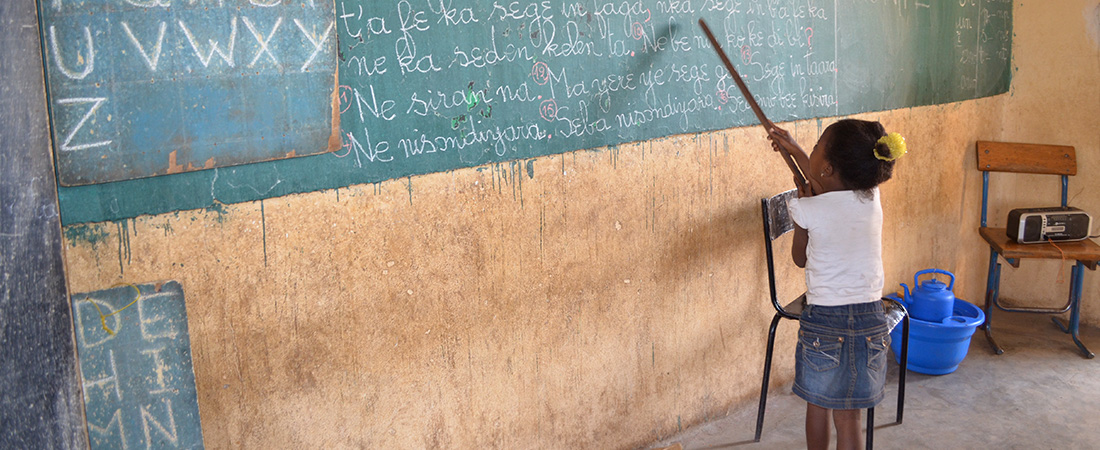Improving Literacy in Mali

SIRA’s balanced literacy method is an application of EDC’s Read Right Now literacy approach, which has been used in 28 contexts around the world. In Mali, Read Right Now has been shown to support dramatic early literacy gains and has become a foundational part of the Ministry of Education’s plan to improve reading and writing across in schools across the country.
At the Fadjiguila Community School in Bamako, 128 second-graders are packed into a single classroom. Benches made for three are holding six. But this school is unlike many others, because despite the classroom’s cramped confines, the children are doing something unusual for their age in Mali. They are reading and writing.
“This is the first time that any of my children is able to write their name in second grade,” says Mariam Traore. Her son Modibo is the youngest of five children, and the first one to attend Fadjiguila Community School. “Modibo writes his first and last name and any other name that we ask him to write. I am very proud of him.”
Fadjiguila has received pedagogical materials and teacher training from EDC’s USAID-funded Selective Integrated Reading Activity (SIRA), a five-year project to improve literacy instruction for approximately 265,000 children in grades 1 and 2 in the District of Bamako and the Koulikoro, Segou, and Sikasso regions of Mali. The school’s enrollment continues to grow as word spreads about what is happening at Fadjiguila and in the other “SIRA schools.”
Teachers at SIRA schools take a different approach to teaching literacy. They provide instruction in Bamanankan, one of Mali’s national languages, instead of French, the country’s official language. (Few students in Mali speak French at home.) Teachers also use a balanced literacy approach, which prioritizes phonemic awareness, reading comprehension, and strategies for decoding words, rather than more traditional memorization-based methods of teaching literacy that are common in Mali.
SIRA schools are also different because teachers employ student-centered, active learning methods, such as singing songs and playing games, to help students learn to read and write.
“Parents in neighboring schools have heard about and seen the difference in our children’s learning,” says Ousmane Diarra, a first-grade teacher at Fadjiguila. “Many are curious about how we teach reading here and have taken their children out of other schools, where class size averages 40 students, and enrolled them in this and other SIRA schools, which often have a higher student-to-teacher ratio. We have been able to demonstrate that transformation in reading abilities is possible, even with very large classes.”
Working in close collaboration with the Ministry of Education, SIRA staff have played a critical role in this effort. They have trained teachers and principals to implement the balanced literacy approach and have also published a series of materials that include leveled readers for children. SIRA staff even wrote and recorded an alphabet rhyme song, extensively used in SIRA classrooms today, that helps children learn the Bamanankan alphabet. These efforts have created caring, fun, and engaging schools where children enjoy learning—and where they learn to read and write years before their friends in other Malian schools.
“In many sixth-grade classes in Mali, kids still aren’t reading,” says EDC’s Adwoa Atta-Krah, project director for SIRA. “But at SIRA schools, you see young kids proudly reading fluently in their mother tongue and writing their names and other words and phrases. It’s amazing to see these younger kids challenge their older siblings in the communities when it comes to reading.”
This focus on learning to read and write in a language that children understand—using a dynamic approach that builds reading fluency and comprehension skills—has implications for the rest of students’ academic careers and for their futures. Research shows that students who master reading in their first language will be able to transfer these skills to a second language later on. This is important in Mali, where French becomes the primary language of instruction beginning in grade three.
But most importantly, parents and teachers in the communities are buying into the approach. It turns out that constantly listening to young children sing alphabet songs and read new words in Bamanankan is a compelling argument for the SIRA approach.
“The most powerful argument for balanced literacy is to simply show people the results,” says Atta-Krah. “That’s been winning them over.”